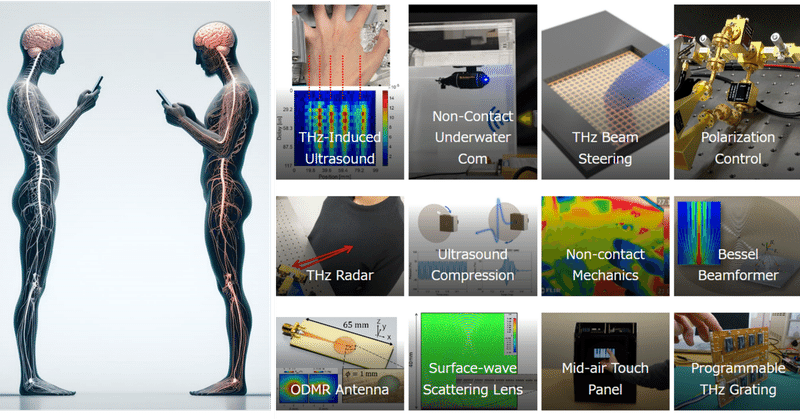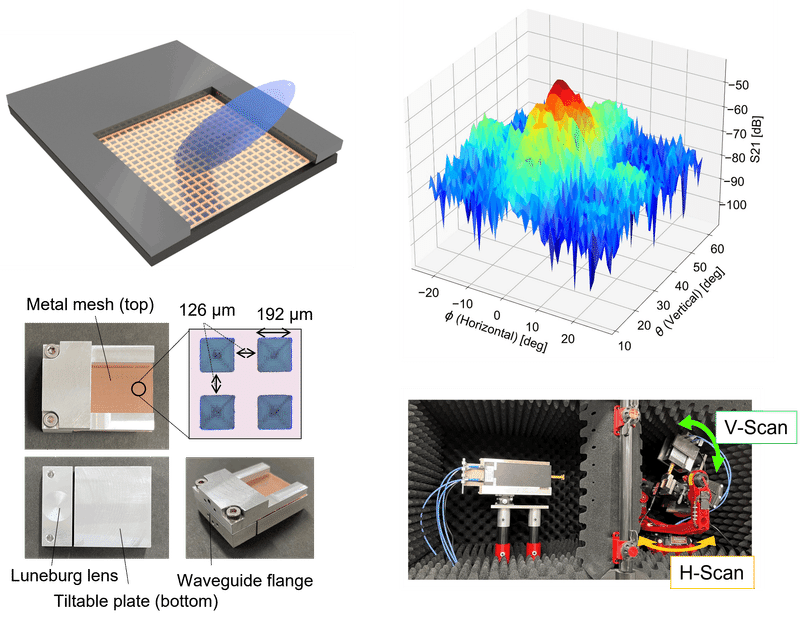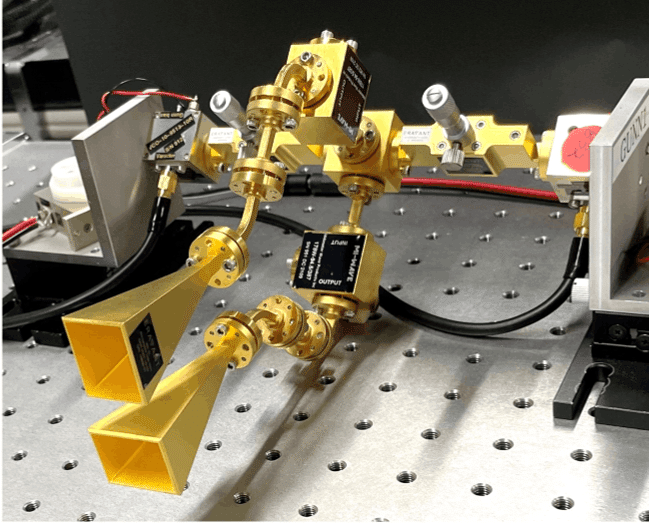
Information Somatics and Terahertz Technology
Introduction
We frequently receive inquiries about the relationship between “information somatics” and “terahertz technology”, which we are working on in the Inami/Monnai Laboratory (Research Center for Advanced Science and Technology / Dept. Information Physics and Computing) of the University of Tokyo. Thus, we explain the concept more in detail here. We hope this information will be useful especially for those who are considering graduate school application. For details of our research results, please refer to our publications. Here is the Japanese version.
What is Terahertz?
Terahertz waves are a general term for electromagnetic waves with a frequency between radio waves and light (approximately 0.1-1 THz). Just as ultrasound is "inaudible sound," terahertz waves are "invisible light."

During the 20th century, it was difficult to treat terahertz waves as a subject of engineering. The main reasons for this were that the frequency was too high to build oscillation circuits from the radio wave side and too low to build lasers from the optical side. However, in the 21st century, the gap between the two has been bridged with the progress of semiconductor technology. With the recent momentum of the worldwide development of Beyond5G/6G, applications to high-speed wireless communications and nondestructive measurement are becoming more realistic.
We believe that terahertz waves are promising as an interface between the physical world and the cyber world and will be important in the implementation of cybernetic technologies based on the understanding of the living bodies from the perspective of communication, measurement, and control.
Terahertz Frequencies
Terahertz frequencies are 2-3 orders of magnitude higher than the radio waves used for smartphones and wifi, and 2-3 orders of magnitude lower than infrared and visible light. When manipulating radio waves, we use metal rods (antennas), and when manipulating light, we use glass balls (lenses). What should we use in the terahertz band then? Also, why do we use different materials even though radio waves and light follow the same equation? Personally, my interest in these similarities and differences was the trigger for starting to research terahertz technology.
The terahertz band has a higher frequency than conventional radio waves, thus providing a wider bandwidth. Also, because its wavelength is longer than that of light, it exhibits transmission and absorption properties different from those of light in many media. To apply these properties in various ways as information carriers or measurement probes, we are often faced with a lack of elemental technologies. Therefore, we are taking a hybrid approach, creating applied systems while creating elemental technologies, or creating software while creating hardware.
Frequency Bandwidth and Information Content/Resolution
In general, communication involves sending information by securing a bandwidth around the carrier frequency. If you only send a single frequency in a delta-functional spectrum, it is like continuing to play a single note from infinite past to future, making it difficult to convey information. To achieve rich expression, the bandwidth must be broadened. If we take an analogy in terms of piano, it is necessary to increase the number of keys (i.e., bandwidth) to allow for various combinations and rhythms. Shannon-Hartley's theorem, which describes transmission capacity, is equivalent to formalizing the variation of possible sounds, including how densely you can arrange the keys against the thickness of your fingers.
The same can be said for measurements. In the time-of-flight camera used for facial recognition on the iPhone, OCT for non-invasive observation of the cross-sections beneath the retinal and epidermal layers, or various radars used in aviation, marine, and automotive applications, the wider the bandwidth of the wave transmitted and received, the more detailed the distance differences can be expressed. Note that measurement is the process of extracting information from an object, and is not so different from communication in terms of both phenomenon and meaning. For this reason, we ourselves dare not distinguish between the two.
As mentioned above, we basically want to have a wide frequency bandwidth, but even if we have an ideally wideband transmitter/receiver, the frequency bandwidth is limited by the antenna, lens, or interfaces such as waveguides or optical fibers. For example, a half-wavelength dipole antenna only works as intended in a frequency band where the antenna length is close to half the wavelength. However, this closeness is relative, so the higher the carrier frequency, the wider the absolute bandwidth (10% of 3 GHz is 0.3 GHz, but 10% of 300 GHz is 30 GHz).
Necessity of Beam Steering
Higher frequency is inextricably linked to shorter wavelength. According to the Friss's transmission formula, the path loss of wireless transmission is inversely proportional to the square of the frequency, so the path loss of terahertz waves is 4-6 orders of magnitude greater than that of conventional radio waves. Therefore, it is essential to compensate for the path loss in order to transmit terahertz waves, and specifically, it is necessary to transmit them as a highly directional beam with a large aperture antenna.
The trouble is that highly directional beams can be easily intercepted or misaligned between transmitters and receivers, so beam steering is required to automatically form and redirect the beam while finding its bypass paths. Therefore, we are focusing our research on beam steering research, which forms the basis of all terahertz applications.

The implementation of beam steering requires consideration of the scale and dynamics of both the human and device worlds. As the wavelength of terahertz waves is on the order of 1mm and the required Rayleigh length is on the order of 1m, structures such as antennas and waveguides have a wide dynamic range, with minimum scales of 10-100um and maximum scales of 1-10cm. Such hybrid macro-micro structures are small for mechanical machining and 3D printing, and large for microfabrication such as MEMS, requiring various ideas for design and fabrication.
For a detailed overview of the technology trends in terahertz beam steering, please refer to this review paper.

Absorption and Transparency
Water appears transparent because it hardly absorbs visible light. On the other hand, water absorbs terahertz waves well, so if we had eyes that could see terahertz waves, water would appear completely black. When light is irradiated onto an absorptive medium, it can be converted into sound through thermal expansion, a phenomenon known as the photoacoustic effect. Since the majority of living organisms are made up of water, irradiating them with properly modulated terahertz waves will produce acoustic waves. We are also working on applications of such phenomena.
In order to utilize acoustic waves in the body as in ultrasonic echo imaging, it is essential to apply a gel to the body surface and adhere the transducer to the body surface for acoustic impedance matching. The use of the photoacoustic effect could potentially bypass this close adherence. Also, when terahertz waves are irradiated onto water, reflection occurs due to differences in refractive index, simultaneous with absorption. Detecting this reflected wave enables non-contact measurement of minute displacements that appear on the body surface, such as heartbeats, through clothing. We call it as a non-contact stethoscope. These non-contact measures can potentially facilitate continuous monitoring in situations where it was previously challenging, such as during daily life or physical activity, not only making measurements more convenient but also potentially having wide-ranging ripple effects in preventive medicine and improvement of sports skills.

Wired vs Wireless
So far, we have discussed the properties of terahertz waves as information carriers and measurement probes. From here, let's consider the direction and possibilities of wireless technology in a broader sense, based on these.
The living body communicates and interacts with others at various levels and modalities. Information is exchanged between cells and organs through the exchange of chemical substances and ions, with others face-to-face through audio-visual and haptic sensation, and between remote locations through transmission channels such as optical fiber and wireless lines.
Inside the body, cables, including nerves and blood vessels, are wired in an extremely complicated manner. Cables are characterized by their spatial selectivity, which enables highly efficient point-to-point transmission of both chemical substances and electrical signals. Information on vital activities is transmitted through countless cables spread throughout the body. The fact that tens of liters of water alone does not seem to become a living organism suggests that it is these information transmissions that characterize life activities.
Naturally, once cables are connected, it is difficult to change their length and connection points. This largely defines the way our bodies are. Telephony (remote hearing) and tele-vision (remote seeing) have extended the human body by virtually wirelessly replacing the cables involved in sight and hearing. The transition from landline telephones to smartphones has changed our behavior and culture more than just eliminating cables and making things convenient. Prof. Masahiko Inami advocates "Jizai" of the body beyond the audio-visual sensation.
Why "seeing is believing"?
In Japanese, the proverb "seeing is believing" is literally translated into "One look is better than a hundred listens." Why is it so? A hint to consider this question is that audio files are typically MB while video files are often in GB when they are of the same length and uncompressed. This difference in data volume can be attributed to the human sensory organs. The eye has a megapixel sensor, whereas the ear has only two pixels. On the other hand, the ear can distinguish sounds up to several tens of kHz, whereas the eye has difficulty distinguishing 10 frames per second. This means that the spatial information capacity is about six digits larger for vision, and the temporal information capacity is about three digits larger for hearing. Thus, from these ratios, it seems we can explain the difference between MB and GB, or in other words, why "One look is better than a hundred listens."
With the evolution of communication technologies from 1G to 5G, it has become possible to wirelessly transmit data from audio to video. Will this kind of information transmission continue to expand in the future? As of now, even those who subscribe to a mobile plan with unlimited gigabytes may not exceed several tens of GB in their monthly usage.
Information Quantity of Intelligence and Sensitivity
Some LLM-based AI seems to be able to run with a local environment of a few tens of GB of memory. This raises the question of how much information is required for intelligence. A huge amount of information is input to human sensory organs, but when meaning and features are extracted from it, it is compressed into a small amount of information. As a result, it becomes easier to memorize, verbalize, and communicate to others. Verbalization of experiences and sensations and the compression of information is an important function of intelligence, but from an information quantity perspective, it could also be seen as energy-saving.
However, the information that is reduced during interpretation due to compression is not meaningless. When I recently played the Nintendo Switch's train simulator "DENSHA DE GO" with my child, as a Super Famicom generation member, I was struck by the detailed CG, but I felt that the fun of the game itself was not much different from the past. If the fun is captured by the intellect and the realism is captured by the sensibility, the sensibility seems to require a greater amount of information. In addition, since the natural world provides us with unlimited amount of information as long as we focus on details, capturing details is especially important for discovering and understanding the unknown beyond our learned knowledge. In the future, when AI as well as humans observe, understand, and express phenomena, there will be an increasing need to treat data with a different standard of resolution than that of humans.
Also, compared to a first-person experience, the amount of information to be handled suddenly increases when sharing experiences with others. The data capacity of the first Super Mario was reportedly only 40kB. This shows that even a small amount of information can immerse the player, while sharing experiences between remote locations, such as online play, was not possible with the technology available at the time. The difficulty of artificially reproducing experiences that occur in front of us is now more widely recognized as Zoom meetings have become widespread.
It is said that there are 10 billion neurons in the human brain, which form a complex network. In recent years, technologies such as large-scale electrode arrays that can be embedded in the cerebral cortex, and functional ultrasound (fUS) that reads changes in minute blood flow in the brain by applying ultrasound imaging, have emerged. Considering the product of the number of channels (spatial resolution) and sampling rate (temporal resolution), it becomes clear that the generated sensor data is too heavy for the current wifi. If these data could be transmitted wirelessly, it would open the way for people and AI to connect with each other through interfaces other than language, and new intelligence would begin to emerge.
Can we express wireless without using negative forms?
With the above issues in mind, we intend to conduct research on terahertz and other wireless technologies in a broad sense. By the way, the words "wireless", "cable-less", or "non-contact" all have one thing in common: they are all expressed in the negative form. In other words, they use the expression "something that should be the default is not there."
However, in the communication that people would intuitively carry out using their eyes and ears, the absence of a cable is not consciously acknowledged. Rather, it seems more natural to consider that state as the default. I learned the concept of retronym from Prof. Masahiko Inami, and I think "wireless" can indeed be called a retronym. Through my research, I'm considering the possibility of coming up with a new word to replace "wireless."
この記事が気に入ったらサポートをしてみませんか?
